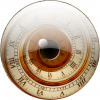Not wonderful, but it's the technique I was after! I have been wanting to make these for so long, and now I've found out how, I hope no-one minds if I share it here. These is my first tutorial here so please be gentle [img]/infopop/emoticons/icon_eek.gif[/img]
I'll do this over a few messages.
First, place a frame on the scanner bed. I used the side of a cake tin with removable base. Fill with pasta and scan. Adjust highlights, shadows and midtones for the best effect, then make a note of the settings. Scan and import into XaraX. Create an unfilled square in XaraX, I used 512pix x 512pix which worked well. Place this over your bitmap until you like what's inside it. Remove line width, set view quality to normal and create a bitmap copy of the invisible square (mine was at 96 dpi - this is set in Utilities> Options> View... Bitmaps, DPI when auto-generated), true colour, no alpha. Now create an invisible square with each side half the original, thus mine was 256 x 256. Align to each corner in turn, making a bitmap copy of each, 4 in total. Then drag the squares into the opposite corners. The centre of the large square is now at the edges, so you can work on the ugly joins you would get if you tiled your original square. Line up the squares using guides, grid, align, and/ or zooming in close.



 Reply With Quote
Reply With Quote




Bookmarks